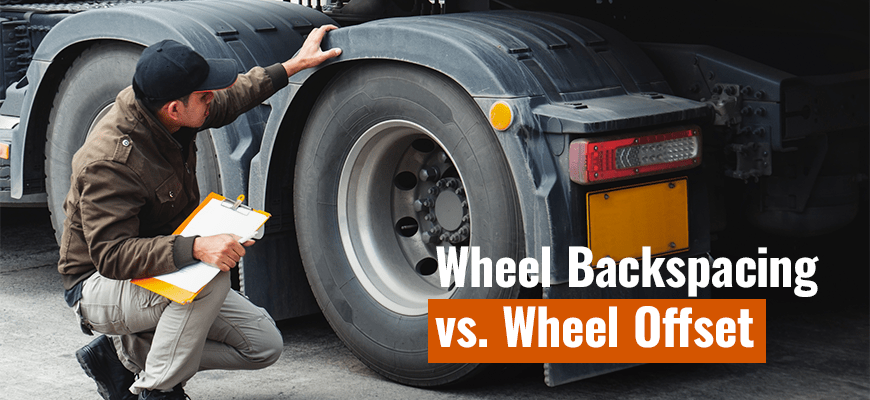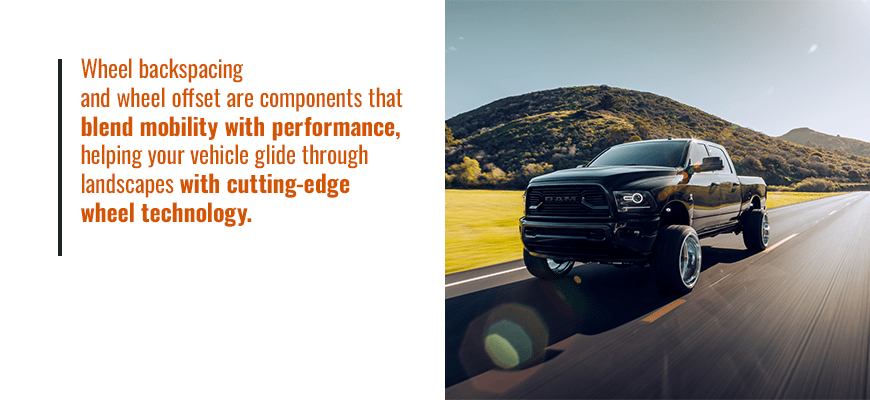

When you are looking to customize your vehicle with new wheels, you will come across terms like wheel backspacing and wheel offset. This is where the rugged meets the rolling to ensure your car performs according to your wants and needs. These components blend mobility with performance, helping your vehicle glide through landscapes with cutting-edge wheel technology.
Whether you are a seasoned gearhead or a newbie dipping your toes into the world of automotive customization, you need to understand the relationship between these two concepts. It will help you find the perfect wheel fitment to upgrade your vehicle’s style and handling.

Offset on wheels refers to the distance between your wheel’s mounting flange — the flat bit on the wheel that fits against the car’s hub and the wheel centerline. The three kinds of wheel offsets you’ll encounter include:
The right wheel offset is crucial for driving performance and visual appeal. Accurate measurements will determine how your new wheels sit in relation to the fender and wheel hub. So, the rim offset measurement starts from the mounting flange and ends at the edge of the rim.
You can find offset specs embossed on the back of your car’s wheels, on the spoke’s rear or on a mounting plate. Look for a number that starts or ends with the letter ‘ET’. Alternatively, look at online tire guides by searching for your wheel’s model name or number.
Wheel backspacing is the secret sauce to determining how wheels sit within the wheel well to bring about balance, functionality and a cool look. Basically, backspacing is the distance between the wheel’s mounting surface and the back edge or lip of the wheel. More distance between these areas lets your car look sleek and tucked-in, but less distance will push wheels outward to make the vehicle’s stance look hard-core.
To size up the personality of your ride’s shoes, lay the wheel on a flat surface, ensuring that it is facing upwards. Next, use a tape measure and measure from the back of the wheel, where the mounting surface meets the inside of the wheel, to the opposite edge of the wheel. The distance between these two spots is the backspacing.
The wheel’s width, offset and backspacing will determine fitment. You must adjust backspacing perfectly, as too much will cause your wheels to rub against the suspension components, but too little can make the wheels stick out like a sore thumb.
You can prevent contact with brake lines and other suspension components by ordering aftermarket wheels that have similar backspacing measurements to your car’s OEM wheels.
Backspacing and offset need to work together for a smooth ride, which can directly affect your car’s fuel economy in terms of wheels and tire size. It is more important to see their relation to each other than to compare the differences. That being said, the following chart describes the basic differences between backspacing and offset.
|
Wheel Offset
|
Wheel Backspace
|
|
| Measurement
|
Offset measures in millimeters
|
Backspacing measures in inches
|
| Calculation method
|
Distance from the wheel’s centerline to the hub mounting surface
|
Distance from the back of the wheel to the hub mounting surface
|
| Inward position
|
Positive offset
|
Higher backspace
|
| Outward position
|
Negative offset
|
Lower backspace
|
You can use either of these measurements to determine the other. For example, if you have nine-inch wheels with a +25 mm offset, you know the mounting flange is pushed about an inch toward the wheel’s outer face. Now, just divide the wheel’s width by two and add or subtract the offset. In this case, the calculation is 9 / 2 + 1 = 5.5 inches. For offset, divide the wheel width by two and minus the result from the backspacing. So, 5.5 – (9/2) = 1 inch or +25 mm.
While this is not necessary to make use of, it is worth knowing that lift kits and suspension upgrades can help your vehicle accommodate different wheel sets or backspacing requirements. If your vehicle often has to navigate tough terrain or extreme weather, changing the tires and enhancing the suspension can help with:
Always consult with a professional if you want to upgrade your vehicle’s suspension to accommodate new wheel offset and backspacing. Sticking to the vehicle’s payload and the manufacturer’s guidelines on customization will help your car or truck stay functioning at its best for longer.
Wheel backspacing vs wheel offset is all about finding a perfect combination. These measurements help you find the sweet spot between driving comfort and style, as too much of either can throw off your car’s balance. When you are shopping for wheels, measure twice and mount once to cruise like a boss.
Whether you need to upfit a truck, trailer, Jeep or SUV, the industry upfitting experts at Truckfitters are ready to help. We are a one-stop shop where you will find all the accessories and top-of-the-line parts your vehicle needs to meet your requirements, including brands like ReadyLIFT and ARIES. For fast turnaround times, flexible solutions and exceptional service, contact us today or find your nearest location and get started.